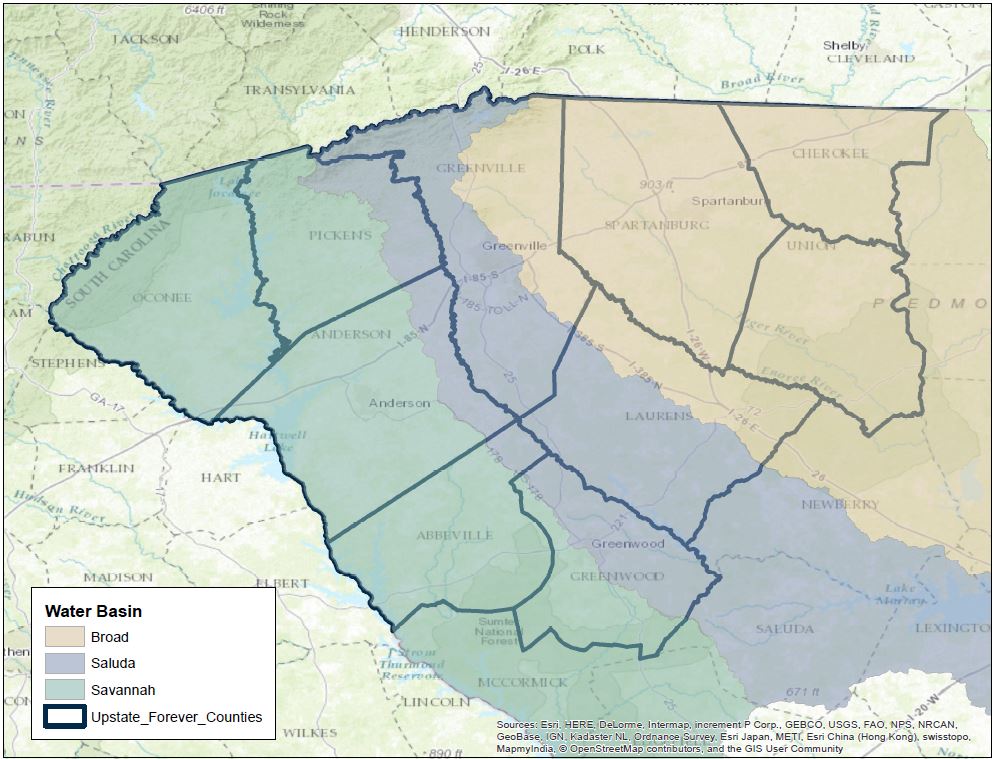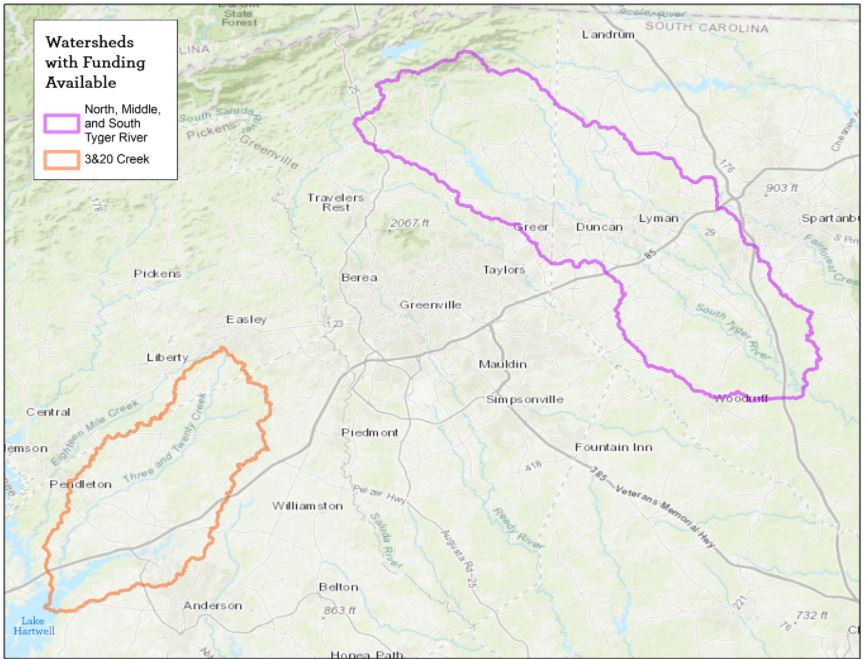What is a Watershed-Based Plan?
March 7th, 2022
Watershed-based planning and implementation is a large part of what the Clean Water team here at Upstate Forever does to protect water resources across the Upstate. But, because this work often takes years to complete and can get rather technical in nature, it can go unnoticed. We hope this information helps to give you a clearer picture of this critical aspect of our work and what you can do to get involved.
First, what is a watershed?
A watershed is an area of land in which all the waterways drain to a single common point. Watersheds come in all shapes and sizes, with smaller ones (think of your local creek) making up larger watersheds. The largest watersheds are known as basins.
In Upstate SC we fall within three basins — the Broad, Saluda, and Savannah — each named for the common point, a river, the watershed drains to. Protecting and maintaining water quality in watersheds is a complicated process as it is highly dependent upon the types of landscapes these waterways flow through.
(What is a watershed? Continued)
South Carolina’s waterways, their health and vitality, are the cornerstone to all things in South Carolina. Our waterways power our industries and homes, with power generation utilizing the greatest volumes of water in our permitting system. Our state’s largest industry, agriculture, uses surface and ground water to put food on our table and feed the growing local food movement. The state’s population and tourists paddle, swim, fish, and boat from our mountain streams to the coasts. Ample rainfall, groundwater replenishment, and clean water help maintain a healthy South Carolina economy.
Maintaining clean water is a very dynamic process, and to do it well, must be done at a watershed level.
What threatens water quality in a watershed?
When rain falls onto the ground, it can do one of two things: flow into the ground and become ground water, or flow on top of the ground and become runoff.
Runoff flows across land surfaces and picks up natural and man-made pollutants that are then discharged into the nearest waterway. This type of pollution is known as nonpoint source pollution (NPS) and is the leading threat to water quality in the US. Examples of sources of NPS pollution in the Upstate include runoff from farmland, livestock facilities, construction sites, lawns and gardens, city streets and parking lots, and forestry.
In contrast, point source pollution is a single, identifiable source of air, water, thermal, noise or light pollution.
What is a watershed-based plan?
In a nutshell, a watershed-based plan (WBP) provides a framework for restoring water quality problems in a watershed. A WBP identifies problems in a watershed, proposes solutions, and provides a strategy for putting these plans into action. WBPs are a collaborative process that includes stakeholder input to help identify issues and develop feasible management solutions for the watershed.
A WBP helps identify known and likely causes and sources of NPS in a watershed. It also helps prioritize NPS issues, identify appropriate best management practices and watershed-based strategies for addressing problems, and develop winning proposals to fund later implementation work.
Who provides funding for watershed-based planning?
The South Carolina Department of Health and Environmental Control (SCDHEC) oversees the Nonpoint Source Program for the state of South Carolina. As part of this work, SCDHEC monitors NPS pollution, unregulated discharges of sediment, bacteria, and nutrients into a waterway. Many different organizations, including Upstate Forever, are eligible to apply to develop WBPs.
Click here to view a list of SCDHEC’s approved WBPs
What’s the difference between watershed-based planning and implementation?
After completing a WBP, Upstate Forever works to secure funding from SCDHEC to implement the recommended strategies, otherwise known as Best Management Practices (BMPs). BMPs are designed to address pollutants of concern, such as bacteria, nutrients, and sediment in watersheds to protect drinking water resources.
Click here to see where we are working now
Homeowners that live in these select watersheds may be eligible for cost-share assistance to install projects on their properties to improve water quality. These funds are made available through SCDHEC’s Section 319 Grant Program. Examples of common water improvement projects include septic tank repairs/replacements, agricultural projects such as cover crops and livestock fencing, and even land protection with conservation easements. Based on eligibility, Upstate Forever can provide up to 60% of the cost of projects!
How can residents get involved with WBPs?
Upstate Forever holds a community meeting at the start of every new WBP development process. This helps our Clean Water team understand areas of concern and water quality issues residents would like to see addressed.
Another important component of WBP implementation is monitoring a measurable difference in improving water quality above and below septic tank repair and agricultural project sites. Residents can get involved with this task by participating in South Carolina Adopt-A-Stream (SC AAS). SC AAS provides the opportunity for anyone interested in protection and improved management of South Carolina’s waterways to be directly involved in their monitoring and reporting. To learn more about SC AAS, visit their website here.
Lastly, landowners within the boundary of our focus areas could be eligible to participate in cost-share programs on their property for projects such as septic tank repairs or agricultural BMP projects. To see if you are within our current project area, see the map below or click here and search your address.
What WBPs have UF’s Clean Water team been involved in, and what is currently in the works?
Our team has collaborated with local partners across the region to complete several WBPs in the Upstate, including Three and Twenty Creek, Lake Greenwood, Lake Keowee, Pacolet River, Saluda River, and the Tyger River watersheds. What’s more, UF in partnership with the Clemson Center for Watershed Excellence, recently kicked off this planning process in the Twelve Mile Creek Watershed, which is expected to be completed by January 2024.
Additionally, our team has completed 319 implementation projects for the Saluda River and we’re actively working on implementation projects in the Tyger River and the Three and Twenty Creek watersheds.
If you live within the current focus areas outlined in the map above and would like to find out if you are eligible for project funding, please contact Clean Water Associate Rebecca Wade at rwade@upstateforever.org.



